IN CONVERSATION
A collaborative text by
Erik Fuhrer and AM Ringwalt
“Just as the text transforms across time and space, I’m interested in the possibilities of mapping one’s subjectivity—how that process might be an invitation for the reader to do the same.”
This conversation between Erik Fuhrer and Anne Malin Ringwalt grew out of a mutual interest in citational and referential poetics. In their work, Erik and AM address concepts of erasure, invocation, and influence in distinct and overlapping ways and in what follows they probe these connections and deviations further to think more deeply about what it means to be writers whose work is, in many ways, grounded by collaboration. This is Erik and AM’s second collaboration, the first being the creative index AM wrote for Erik’s book, in which I take myself hostage (Spuyten Duyvil Press, 2021).
*
AM: In your introduction to VOS, you write toward “What it felt like. When a book spoke.” You talk about bringing Virginia Woolf’s The Waves to your classroom, a book marked by your engagement with it: “Dog ears, notes in the margins, underlining.” I’m interested in the possible dynamic between annotation and erasure in VOS and At Root. Are these works at all maps of your experience(s) of reading? Are you foregrounding the books’ initial impressions on you (The Voyage Out and Waiting for Godot) through erasure?
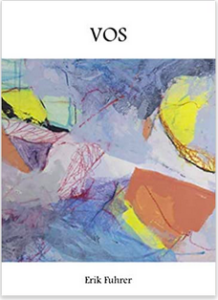
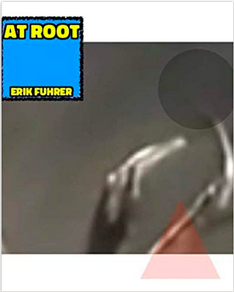
E: My annotations are all about mapping the complex contagion of the reading act. Though sometimes tracking the “meaning” of the text, they are often more so developing new patterns of entry that are particular to me, the way I read, and the way the work is affecting me at that particular moment. Nothing is ever pure, we are always mucking things up together, so erasure felt like the perfect way for me to take this resonant network of my own engagement and give it its own shape. This process preserved parts of the original text while at the same time highlighting my own reading experience, or memoir of thinking alongside the text, as well as the ideas from the text that resonated most deeply with me. This produced an entanglement rather than an analysis, which envisions texts as porous and malleable, and good to think with, and muck around with, in order to discover new possibilities, and spark new ways of living alongside another’s writing in a dynamic relationship that seeks out new applications and engagements for relating and worlding.
I was always interested in the idea of scholarship as creative engagement—an act that opens up the text to new possibilities engendered by the individual reading experience as well as new theoretical modes of seeing and interacting. I’ve often heard the caution not to let theoretical or personal interests get in the way of the reading of the text. Yet this advice always seemed to advance a purity thesis that fetishizes the literary object, as if the theoretical or the personal were not texts in their own right, and as if pollution was just unidirectional. Virginia Woolf’s works polluted me long ago, and many times helped me enter into dialogue with my theoretical interests.
AM: You simultaneously employ erasure and addition in your work—whittling down a source text, but also introducing new visual elements. The visual elements of At Root are almost map-like in their use of arrows and recurring shapes. At the end of the book, you reveal that the artwork is intended to be “a visual representation of the accompanying text.” How do you go about translating text into image? What motivates your movements into and out of these forms?
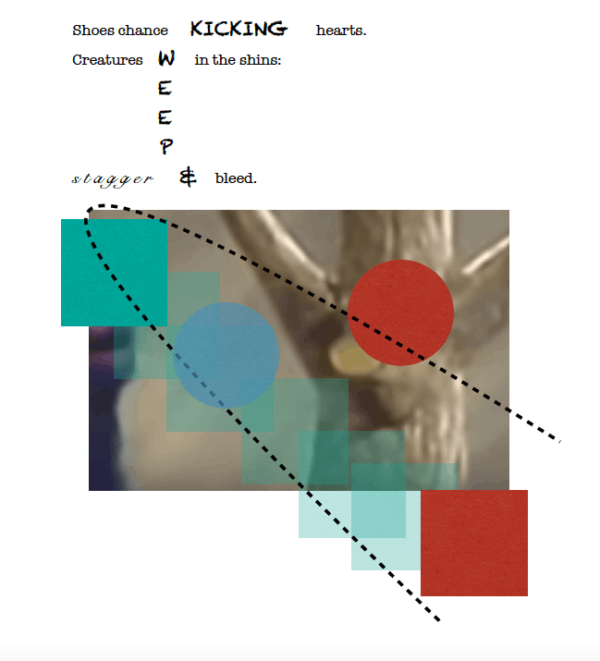
E: I always thought that Beckett’s plays might be best represented by object theatre, particularly with found objects, because of the ways the human is almost redacted from many of his texts—the characters in Play (1963) and Hamm’s parents in Endgame (1957) come to mind. People are human nonhuman assemblages: “human” characters in containers that blur lines between environment, embodiment, and individuality. Beckett himself engages with object theater in Not I, which features a singular mouth monologuing in the surrounding dark. In this play the mouth functions not as synecdoche for the human body but simply as a mouth, opening and closing, producing rapid sound.
In Waiting for Godot, the characters also sit on the precipice of objecthood. In the first act, Didi and Gogo talk about hanging themselves, after which Didi notes that doing so will result in an erection, explaining that “where it falls mandrakes grow.” This line has always fascinated me, in the way that it in its dark irony suggests the body as rooted, as root itself, which is compounded and complicated by the fact that all they eat is turnips and carrots. There is clearly humor here, but it is a humor, I think, that exists alongside a more serious comment on the connective tissue between the human and nonhuman that is becoming, and perhaps always was, even more tenuous for Didi and Gogo as we meet them in the play. I am more interested in the latter, and it is this reading of the play that led me to title my book, At Root, and to examine what it would look like to already imagine the play as a narrative of the nonhuman.
Since the haiku are less theatrical, in that they aren’t meant to be “performed,” they seem best represented by static objects that point toward their own theatricality and movement, which is latent, even if impossible. They capture the shedding of a play into a poem. Like the redacted texts, with their own shape and drama, hopefully tell truths about the original in a more molecular way, the art focuses the dramatic energy into shape and trajectory at the same time that it resists the original text as a hermeneutical.
AM: I’d like to learn more about the role of assemblage and narrative in your most recent book, in which I take myself hostage. This, to me, feels like the most intimately personal of the three works we’re discussing. Here, too, you incorporate paintings as a kind of formal and thematic entanglement, to use your word. And, even though the words “my body” throughout the book should suggest a static self, the voice of the book is anything but—I almost feel absorbed within it as I read, as if your text is an effacement (or vigilant examination) of self that somehow implicates me in its movement.
E: Donna Haraway writes, in When Species Meet, that “to be one is always to become with many,” referring to the ways in which the complex assemblages of nonhuman entities that mingle on and within our bodies dispel the myth of pure singularity of the “I.” In in which I take myself hostage, the “I” is sometimes individuated voice, is sometimes spores, sometimes infiltration and infection of both the I and the reader: “I will spore you.” At times the book wants to connect with the reader on an interpersonal and emotional level and at other times it wants to form a messy assemblage with the reader, and sometimes there is a lack of differentiation between the two, in terms of motivation and activation.
I have always been fascinated by strange duality of the word “subject” in the English language: depending on its context, it can signify a linguistic position of power, i.e. the subject of a sentence, or a physical position of being under the power of, i.e. the king’s subjects, or the act of being under a certain power, being subject to a system or law, or disempowered or objectified, if this system or law is corrupt or violent. in which I take myself hostage recognizes and plays with this dual nature of this term, to be the subject of and subject to the assemblage of selves that unfold throughout the bodies that form the flesh and voices that echo throughout this book.
I decided to list the entire work in the table of contents rather than individual poems or paintings mainly because I see each work as a textual and visual equivalent to the concept of becoming with many highlighted by Haraway.
AM: That tension between power and subjugation is fascinating—how the word subject contains both possibilities. I’m thinking, now, of the way Kim adds to the multiplicitous forms of connection and of becoming (self, spore, self/spore, etc.) through painting. I’m struck by the almost overflowing qualities of Kim’s paintings—especially in contrast to your works of visual erasure. Thinking of the paintings as spores.
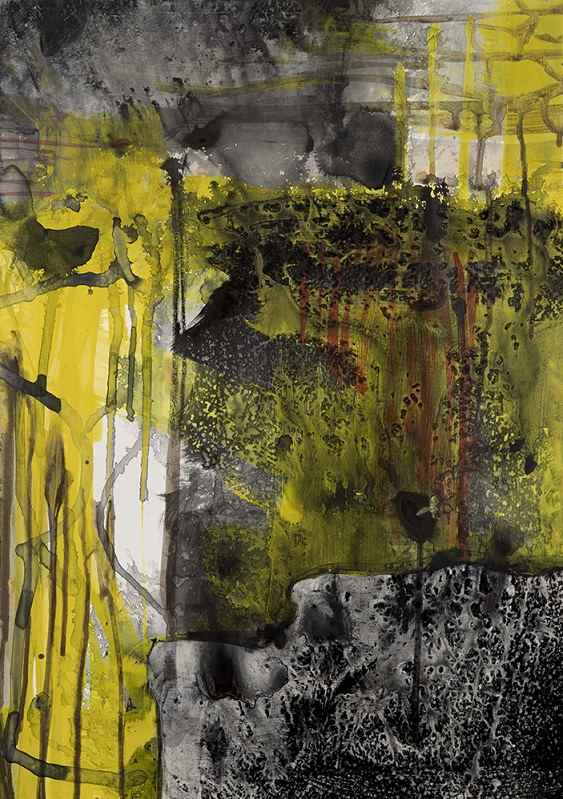
E: It’s interesting that you bring up the paintings in the context of the subject’s dual linguistic function as it is often hard to trace whose work is the subject of or subject to the work of the other in our collaborations. My poetry was partially the subject of Kim’s painting, as she created them in response to the finished texts, so in the case of in which I take myself hostage, Kim’s paintings were literally the spores. That said, my work has also always been the mold, so to speak, growing at the edges of hers: the colour, the shape, heavily influencing and incubating their growth. Kim’s paintings in my first book, not human enough for the census gestated and bred the poems in in which I take myself hostage. Kim’s paintings themselves represent this breeding and excess, not influence or representation. To determine the origin of artistic influence is sometimes to make an omelet of the chicken and egg. My visual works in VOS and At Root were in ways hermeneutical tools or, as you said earlier, a mapping. I conceive of the text and art in hostage as more symbolic: not poem and art but a twined becoming, a mutual sporing.
The sporing of personal history and narrative that occurs in in which I take myself hostage first started breeding in my first book, every time you die, which scatters the text across the page in a simultaneous embracement and dislocation of the lyric “I.” Though this book’s subject, the “I” is more consistent, the subject, the who or what the book is writing to/for/at/into is more chimerical and often nonhuman. in which I take myself hostage is kind of an assemblage of this book and my second book, not human enough for the census, in which the “I,” and the dual conceptual nature of subject, is continuously deconstructed, enmeshed, and regurgitated in a plural mouth of language that is simultaneously attempting to rearticulate a subject and recognizing the perhaps impossible limitations of doing so. in which I take myself hostage sees, I think, more possibility in this construction, seeking a lyric “I” similar to that of every time you die while at the same time being subjected by, as Woolf puts it in A Room of One’s Own, “a straight dark bar, a shadow shaped something like the letter ‘I.’”
every time you die concludes with a full-length erasure of T.S. Eliot’s The Waste Land, my first attempt at the form. Other than The Waves, this is perhaps my most annotated text. The annotations are doubly my attempt to “understand” the poem and the ways the poem seemed to resonate within the context of the now, particularly the anthropocene. As I’ve alluded to above, I have developed a kind of fraught relationship to literary analysis over the last few years, especially in relation to the idea that texts mean something in and of themselves, as often expressed by the phrase, “stay true to the text.” I think reading and interpretation is at its most interesting when we allow the texts to spore and form new connections across space, time, and ideas. My erasure of The Waste Land was a type of memoir of sorts: of my personal interaction and reading history with the text, as well as my own personal history that I had been exploring throughout the rest of the book. My memory work was both the subject of and subject to the reading and erasing of Eliot’s poem, forming a text that was at once singular and plural.
AM: Just as the text transforms across time and space, I’m interested in the possibilities of mapping one’s subjectivity—how that process might be an invitation for the reader to do the same. What was it like to use ‘yourself’ (or, following the idea of “assemblage,” yourselves) as the material for this book, vs. Woolf in VOS and Beckett in At Root? How do the paintings correspond to this “self”?
E: As in The Waste Land erasures, the self is embedded in VOS and At Root, though it is admittedly very differently expressed than the more deliberately articulated subjectivity found in in which I take myself hostage. In VOS and At Root, there is as much subjective mapping, though it is so deeply rooted, and knotted within the practice of erasure that it is itself partially, or perhaps wholly, redacted. The subjectivity in these books expresses morseo my personal relationship to ideas and theories of the human, nonhuman, and my own, or the texts own entanglement with them, rather than the more physical subjectivities and vulnerabilities exposed and explored in in which I take myself hostage.
The greater personal exposure expressed through books like every time you die and in which I take myself hostage is admittedly difficult for me as a writer, yet I find myself ever more compelled to explore this vulnerability lately. Yet, I feel like I need a conduit to do so. For every time you die, this was The Waste Land as well as the original poems of my own that I erased, for in which I take myself hostage, it was Kim’s paintings. I have currently finished a memoir that focuses deeply on personal trauma, something I never thought I would broach in my writing. This latter project has had a lot of attempts and false starts over the years. It wasn’t until one day Buffy the Vampire Slayer showed up in one of my poems that I realized I had found a companion fitting for this journey.
For in which I take myself hostage in particular, it is significant that the paintings by my partner, Kim, are part of the enmeshment. While I want to avoid treading into the sentimental trappings of concepts like soulmates, there was something intimate about co-constructing a piece of art together with someone that I am deeply enmeshed with on an everyday basis, as if there was some kind of blurring of selves, at least in the way they are expressed in the book, in the same way I hope there will be so for the reader, “implicating,” as you said above, you “in its movement.”
*
The idea of someone listening—not silence, but an un-sensed leaning in.
An envelope
of noise
silenced
by the flap
buzzing within
and stuffed
but not visible,
though also not invisible.
An invisible sound from beyond my kitchen walls—
unseen, it could be wind or plane.
I see it’s wing
tips vibrating
like a pudding
that I have
disassembled.
Like molecules
in a new
mouth.
*
E: Your own expressions move from prose to poem to white space and your inclusion of others’ words are sometimes formed as journal entry, sometimes as research quotation and citations. Can you talk about the shifts in genre here and how the particular arrangement of your work offers new ways of thinking or contextualizing about what can be possible in certain forms as well as within spaces that pass through or run adjacent to other voices?
AM: I tend to shift genres when I perceive a limit in whatever form I’m writing through. Poetry allows me to leap out of narrative, and prose allows me to really sit in whatever energy typically catalyzes my poetry. When I incorporate other voices into my writing through quotation, I’m writing against my own limits. What might I not have the words for? Why? Quotation helps me foreground my subjectivity—I show my hand to my reader through transposing other texts. Most of my writing is motivated by listening—to myself, to my surroundings, to what moves me. By incorporating other voices in my writing, I perform my listening and invite my reader to listen with me.
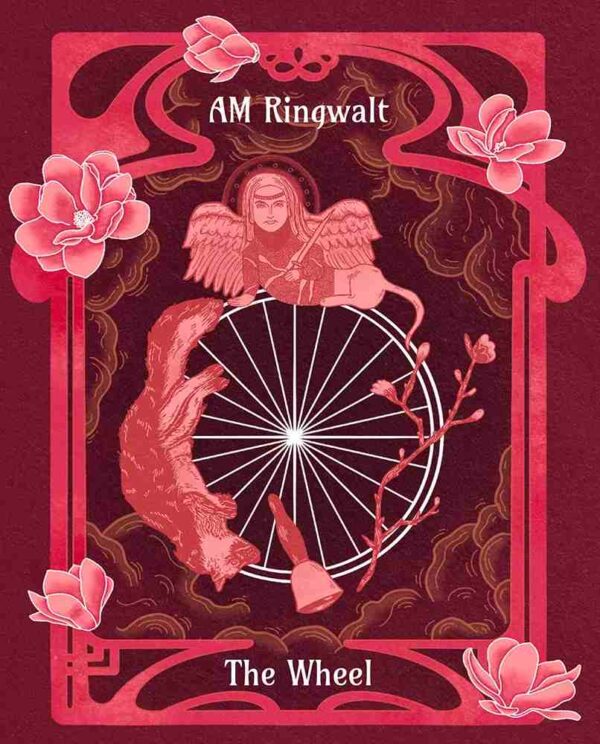
E: I really love this idea of listening as an active act occurring on the page. So interesting how a change in language, from “reading” to “listening” to describe the act of encountering a book kind of changes the affective nature of “reading.” Can you talk more about the role of the reader in your work, as well as how the text object itself works to enact a particular type of transmission between you, the words, and those that come upon them?
AM: I’m much more motivated by sound than sight. For me, vision feels obvious at best and discriminatory at worst. Most of the sonic aspects of my writing are driven by moments when I hear a sound but don’t know what it is or where it’s coming from. In What Floods, I write about hearing a dog bark at its own echo, and walking through the space between the bark and the echo. That scene, as much as it appeals to image in its description of the hill and the dog, gains its depth through sound.
In a similar way, I approach reading with my ears as much as possible. Of course, I can’t read without sight, but my conception of listening makes room for more of an associative meaning-making. In that vein, I try to create occasions for my reader’s listening throughout my writing. Recurring phrases serve as echoes, as moments for the reader’s recognition: I’ve heard this before. I ask my reader to listen to a particular song. I think about the meaning of an earlier phrase, exploring the connections through sound; in The Wheel, “as I write, I wonder” becomes “I wonder as I wander.” Vowels are everything, my sonic symbols. I’m more interested in the ways in which my reader discerns meaning through the associative sounds of my writing (associations stemming from their subjectivity) than in my writing as a fixed object.
E: I am fascinated by the positioning of the reader as a performer in “Note for Performance” in What Floods—so that the act of reading is immediately framed as active, collaborative, and deeply intimate—a sentiment echoed at the end when you write: “Take a picture of yourself on the floor and send it to me. Or, take a picture of yourself on the floor and place it here—on this page.” It’s as if the page is simultaneously in front of you and in front of the reader—that you would be able to instantly see their photo—there’s something telekinetic about the page—how does the relationship between absence and presence provide space and possibility for communication across space and time?
AM: The absence of a photo on the page you mentioned—where a reader might “take a picture […] on the floor and place it here—on this page”—represents, to me, the possibility of choreographic poetry. The absence of a photo on the page allows for any kind of engagement with the text—from any time and any space. By placing this invitation at the end of the book, I’m encouraging my reader to pick off from where I leave—to move into and out of my text. Again, I suppose it’s a way of recognizing my limits as a single author. I’d rather write in relation to others.
It’s so great that the photo-invitation stood out to you. About a year before writing What Floods, I met a choreographer named Cinthya Oyervides at a summer residency at the Watermill Center. At Watermill, Cinthya and I began an ongoing collaboration exploring how poetry might be choreographic. We’re both really invested in complicating the dynamic between artist and audience. If a poem can be a choreography, it asks something of its reader (its audience)—it might literally move them, too.
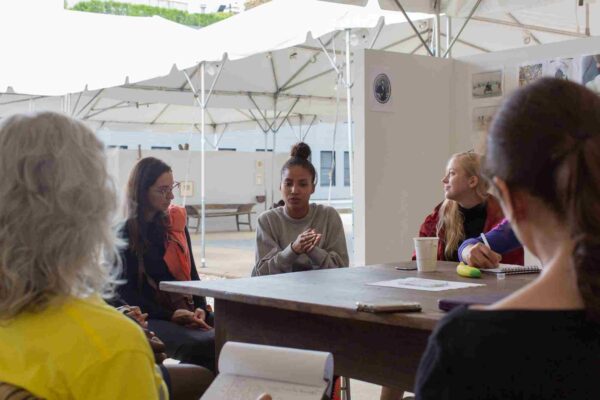
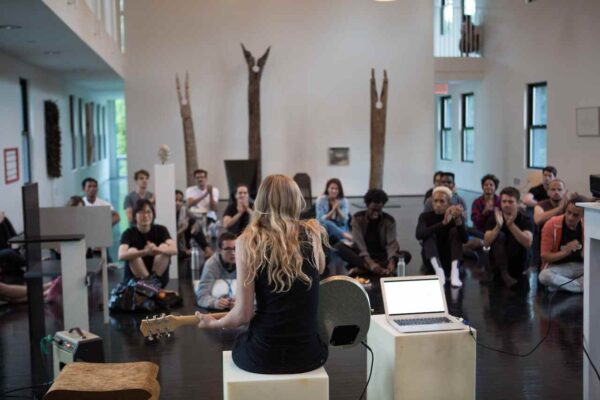
E: The text as choreography is something I’ve never thought about before and is actually really interesting. What you say also reminds me of those Choose Your Own Adventure books I used to read as a kid. I always found them disappointing, I think because I wanted to have more multidirectional interaction with them. Clearly, you are doing different work, but I think the emphasis on trying to create a connection with readers, beyond just the act of reading, is fascinating. Have you considered digital platforms that might allow for more direct encounters where people can actually upload their photos—or is there also something necessary about the lack of connection presented by the page that drives the choreography for you?
AM: I love the lack of connection. Maybe I’m just technologically-averse, but the tension between inviting participation and then not actually being able to perceive or witness my reader’s participation is sacred to me. It’s also a way of honoring my reader—of trusting their privacy, of trying to feel them with me even though I can’t picture them, can’t know them.
Also, there’s loss—not always, but often—on the other side of connection. They might be mundane losses, too: saying goodbye to a brother, a grandmother, a friend, not knowing when another coming together will be possible.
In her essay “Contradiction,” Simone Weil writes:
The existence of opposite virtues in the souls of saints: the metaphor of climbing corresponds to this. If I am walking on the side of a mountain I can see first a lake, then, after a few steps, a forest. I have to choose either the lake or the forest. If I want to see both lake and forest at once, I have to climb higher.
That’s a kind of loss, right? A kind of limit, at least.
I’ve been writing a lot lately about the loss on the other side of connection, about the idea of not being somewhere. My grandparents live in California and there’s no way I can safely see them during the pandemic. I write about traveling through space as traveling through “not California.”
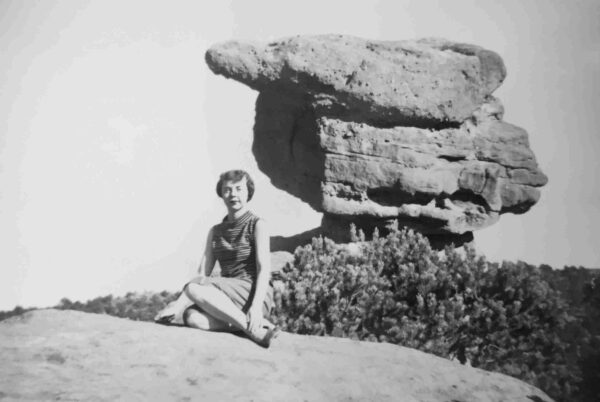
E: What you say seems to evoke a potential psychic energy held in these physical pages, as if the lack of ability to actually “see” the other person respond produces a new kind of affect across the wires, whether or not it is ever received, or perceived to be received. Spaces where a telekinetic crossing from the world to “not California,” which I find very resonant, is both imprinted yet also but a trace of that imprint. Almost like instead of pen pals, there are some sort of spirit pals at work here, or mind whisperers. So that, in a way, you too are working very much with the concept of erasure. Do you find that concept useful or operative in your work?
AM: I love that; “almost like pen pals” … but not. Something quieter is at play, for sure.
It’s interesting to see you bring erasures into this discussion, in this particular context. What Floods, at least, was in part motivated by “erasures” that were forced upon me by way of PTSD blackouts: my inability to recall both crucial and mundane information, experience, violence. What Floods is about an Edith Piaf song, “Mon Dieu,” but I didn’t know that as I was writing the bulk of the book. The book is an act of deciphering my mind-as-erasure: what floods me? For some reason, this song was the flood. This song brought back the erased and displaced memories.
That being said, at least in What Floods, I believe that I’m the erasure, and my readers provide—through their own subjectivities and willingness (or unwillingness) to participate in the collaborative aspects of my writing—some kind of sacred relief. Where I pause—or where I can’t continue, for reasons beyond me—they might speak (or sing).
E: I am also interested in the material vs immaterial transmission, how you track, or don’t track, its path, and what the voice(s) in this book are tracing visually, sonically, and spatially, in terms of the spectre realm this book seems to pull the curtain from.
AM: These transmissions feel endless. What Flood reaches beyond itself, beyond the limits of the form a book might impose on a poem. Crucially, it renders me as its initial performer—allowing me to reclaim my body, which has been stuck for so long in so much violence. In this reclamation, in this re-staging, a new space opens up. That’s where the reader comes in, at once witness and participant.
*
How do you annotate during a time of death?
Grief a shadow Cancel
that squawks the words back
into teeth. How do you bite down
in the drag
of silence?
Is erasure an act of grief?
Grief
the
teeth.
of silence?
Note:
Erik Fuhrer’s book of poetry and collage, Eye, Apocalypse (forthcoming 2021) and poetry book in which I take myself hostage (2021), with artwork by Kimberly Androlowicz, are both published by Spuyten Duyvil Press. Another poem and art collaboration with Kimbelry, not human enough for the census is available from Vegetarian Alchoholic Press (2019). Erik has also published 3 books of erasure: At Root, (Alien Buddha Press, 2020), with digital art by the author, VOS (Yavanika Press, 2019) with collages by the author, and every time you die (Alien Buddha Press, 2019) with art by Marcel Herms.Note:
An excerpt from AM Ringwalt’s What Floods was published in 2020 by Peripheries. What Floods was a finalist for Essay Press’ 2018 Book Contest and was longlisted for Tarpaulin Sky’s 2019 Book Awards. The Wheel was published in 2021 by Spuyten Duyvil.